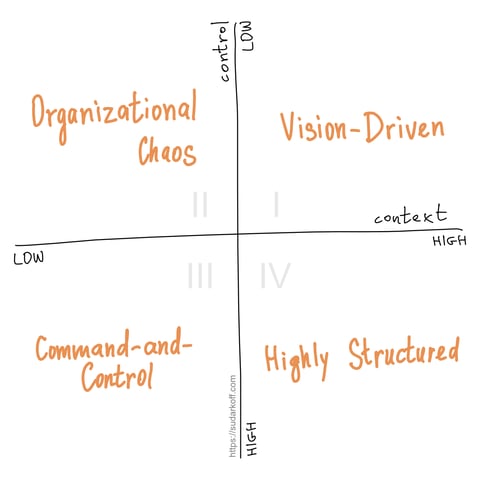Control and context in leadership are often seen as opposites.
Some leaders rely on their positional power and authority to direct others. Giving orders and expecting compliance from subordinates without much explanation or input from them.
While others focus on empowering their team by helping them understand the larger goals and context of their work. Communicating openly about organizational mission and strategy so the team grasps the bigger picture and can make their own decisions.
But what if control and context were not only independent variables worth focusing on under different circumstances, what if sometimes it was beneficial to maximize both?
What if, by treating control and context as separate levers, and not attaching either negative or positive connotations to them, we could create better, more resilient organizations?
One of my favorite tools to use when I want to tease apart concepts is to throw the extremes on two orthogonal axes and see if they make sense on their own:

Looking at the image above, I can see that each of the four quadrants can represent a possible real-life situation. (I can even think of a few of my former managers whose leadership style would fit in three of these quadrants.)
Let’s explore each quadrant.
I. Low Control, High Context: Vision-Driven
Organizations that fall into this quadrant are characterized by a high level of autonomy given to their employees, and alignment around purpose. These organizations prioritize self-management and open communication.
Very few rules are prescribed because everybody understands what’s expected of them and why. The employees are engaged and motivated to innovate and to do their best work every day without a lot of direction and oversight .
On the other hand, vision-driven organizations that lack structure could create confusion around roles and responsibilities, which could lead to poor execution of ideas and vision.
II. Low Control, Low Context: Organizational Chaos
Working at a company in this quadrant could be a frustrating experience. Despite the high autonomy that employees enjoy, there might be a general lack of alignment on vision and direction. It might feel like everybody’s just doing their own thing.
The roles in these organizations tend to be loosely defined and there's often a lack of accountability. Which could lead to employees feeling isolated and disengaged.
The lack of structure, however, could be beneficial for an early-stage company. Unrestrained, creativity and innovation could run wild and incredible breakthroughts could be achived very quickly.
For the right person, this could be a golden opportunity to lead the organization into the first quadrant.
III. High Control, Low Context: Command-and-control
Organizations in this quadrant typically have a hierarchical culture.
There are likely numerous rules, and strict enforcement is prioritized. Very often there's an emphasis on process efficiency. There's very little room for creativity.
On the one hand, this could make it easy to succeed for employees who are great at following the rules. But it can also lead to risk aversion, mistrust, and micro-management.
Employees in command-and-control organizations often become disengaged and burned-out from the constraint and pressure. Turnover is often high.
IV. High Control, High Context: Highly Structured
Organizations that operate in strictly regulated industries often fall into this quadrant. When the cost of a mistake could be somebody's livelihood or even life, regulatory compliance is prioritized and risk mitigation is of the utmost importance.
As a result, there are often strict rules that everybody must follow. And audits are common.
These organizations tend to be strategy and vision focused. And a culture of empowered leadership, coaching and development is also common in such organizations.
Potential dangers and challenges in this quadrant include poor innovation constrained by rigid hierarchy, employees feeling micromanaged, and slow decision making due to the lack of autonomy.
Where are you in this picture?
Which quadrant does your organization fall into? Does it make sense for your org? If not, what can you do differently to move it into a more appropriate quadrant? Are there areas of your business where different quadrants might make more sense?


